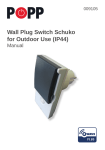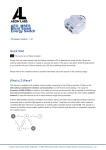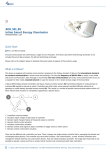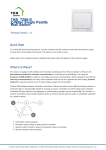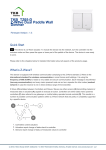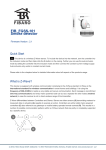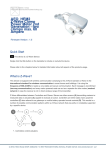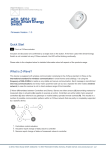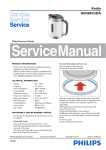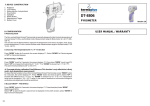Download PHI_PAN08 Relay Insert for Blind Control - Z
Transcript
PHI_PAN08 Relay Insert for Blind Control Firmware Version : 1.0 Quick Start A This device is a Z-Wave Actor. Tripple Click the Button on the device confirms the inclusion, exclusion and association. After power up it will stay in auto inclusion mode for 4 minutes. To support handling of the device when already installed the external switch can be used for inclusion or exclusion for 3 minutes after power up. Please refer to the chapters below for detailed information about all aspects of the products usage. What is Z-Wave? This device is equipped with wireless communication complying to the Z-Wave standard. Z-Wave is the international standard for wireless communication in smart homes and buildings. It is using the frequency of 868.42 MHz to realize a very stable and secure communication. Each message is reconfirmed (two-way communication) and every mains powered node can act as a repeater for other nodes (meshed network) in case the receiver is not in direct wireless range of the transmitter. Z-Wave differentiates between Controllers and Slaves. Slaves are either sensors (S) transmitting metered or measured data or actuators (A) capable to execute an action. Controllers are either static mains powered controllers (C) also referred to as gateways or mobile battery operated remote controls (R). This results in a number of possible communication patterns within a Z-Wave network that are partly or completely supported by a specific device. (c) 2012 Z-Wave Europe GmbH, Goldbachstr. 13, 09337 Hohenstein-Ernstthal, Germany, All rights reserved, www.zwaveeurope.com - pp 1 1. 2. 3. 4. 5. 6. 7. Controllers control actuators Actuators report change of status back to controller Sensors report change of status of measured values to controller Sensors directly control actuators Actuators control other actuators Remote controls send signals to static controllers to trigger scenes or other actions Remote controls control other actuators. There are two different role a controller can have. There is always one single primary controller that is managing the network and including/excluding devices. The controller may have other functions - like control buttons - as well. All other controllers don't manage the network itself but can control other devices. They are called secondary controllers. The image also shows that its not possible to operate a sensor just from a remote control. Sensors only communicate with static controllers. Product description The in-wall Roller Shutter Controller is designed to switch rise/lower roller shutter connected to its terminals using Z-Wave or push buttons directly connected to this Roller Controller. Additionally the device is measuring the power consumption and report it to a controller on request. The metering function is also used to protect the device from overload. The new smart relay calibration technology can reduce the inrush current caused by the load and let the module work perfectly with many kind of roller shutter. This in-wall Roller Shutter Controller is able to detect position of the Shutter by using the patented power measuring method, so it can be remote controlled not only fully up or down , but also can be adjusted to ex. 30% or 50%. And when manual controlled by push button, the controller also can memorize the position and send the new shutter position to its Z-Wave wireless controller (ex. IP-Gateway). This device is designed for a 3 wire system and needs a neutral wire in the wall box. Before Device is installed Please read carefully the enclosed user manual before installation of the radio-actuator, in order to ensure an error-free functioning. ATTENTION: only authorized technicians under consideration of the country-specific installation guidelines/norms may do works with 230?Volt mains power. Prior to the assembly of the product, the voltage network has to be switched off and ensured against re-switching. The product is permitted only for proper use as specified in the user manual. Any kind of guarantee claim has to be forfeited if changes, modifications or painting are undertaken. The product must be checked for damages immediately after unpacking. In the case of damages, the product must not be operated in any case. If a danger-free operation of the equipment cannot be assured, the voltage supply has to be interrupted immediately and the equipment has to be protected from unintended operation. Installation Guidelines (c) 2012 Z-Wave Europe GmbH, Goldbachstr. 13, 09337 Hohenstein-Ernstthal, Germany, All rights reserved, www.zwaveeurope.com - pp 2 Place the in-wall switch into a wall box and connect the pins as shown in the figure. Calibration It is important to carry out a shutter calibration process before you control the shutter to move. Press ZWave button over 3 seconds and release before the 6th second, the roller shutter controller will start the shutter calibration process. The process is composed of three continue stages. The shutter move to the TOP in first stage, and move to the BOTTOM in second stage, and move to the TOP again in third stage. Then PAN08 will know the total range of UP and DOWN. During the shutter calibration process, any emergencies happen you can press and release the button to stop the process. Behavior within the Z-Wave network (c) 2012 Z-Wave Europe GmbH, Goldbachstr. 13, 09337 Hohenstein-Ernstthal, Germany, All rights reserved, www.zwaveeurope.com - pp 3 I On factory default the device does not belong to any Z-Wave network. The device needs to join an existing wireless network to communicate with the devices of this network. This process is called Inclusion. Devices can also leave a network. This process is called Exclusion. Both processes are initiated by the primary controller of the Z-Wave network. This controller will be turned into exclusion respective inclusion mode. Please refer to your primary controllers manual on how to turn your controller into inclusion or exclusion mode. Only if the primary controller is in inclusion or exclusion mode, this device can join or leave the network. Leaving the network - i.e. being excluded - sets the device back to factory default. If the device already belongs to a network, follow the exclusion process before including it in your network. Otherwise inclusion of this device will fail. If the controller being included was a primary controller, it has to be reset first. Tripple Click the button on the device confirms inclusion and exclusion. After power up it will stay in auto inclusion mode for 4 minutes. To support handling of the device when already installed the external switch can be used for inclusion or exclusion for 3 minutes after power up. Operating the device The manual operation of the blindcontrol is using traditional switches with two switched inside. One switch turns the blind in one direction, the other blind turns the blind into the opposite direction. In case the motor is active due to the switching of the external switches all wireless commands are ignored. There is no start/stop function implemented with the external switches but direct control of the movement only. Node Information Frame NI The Node Information Frame is the business card of a Z-Wave device. It contains information about the device type and the technical capabilities. The inclusion and exclusion of the device is confirmed by sending out a Node Information Frame. Beside this it may be needed for certain network operations to send out a Node Information Frame. Tripple Click the button on the device sends out a Node Information Frame. Associations A Z-Wave devices control other Z-Wave devices. The relationship between one device controlling another device is called association. In order to control a different device, the controlling device needs to maintain a list of devices that will receive controlling commands. These lists are called association groups and they are always related to certain events (e.g. button pressed, sensor triggers, ...). In case the event happens all devices stored in the respective association group will receive a common wireless command. (c) 2012 Z-Wave Europe GmbH, Goldbachstr. 13, 09337 Hohenstein-Ernstthal, Germany, All rights reserved, www.zwaveeurope.com - pp 4 Association Groups: 1 (max. nodes in group: 1) Configuration Parameters Z-Wave products are supposed to work out of the box after inclusion, however certain configuration can adapt the function better to user needs or unlock further enhanced features. IMPORTANT: Controllers may only allow to configure signed values. In order to set values in the range 128 … 255 the value sent in the application shall be the desired value minus 256. For example: to set a parameter to 200? it may be needed to set a value of 200 minus 256 = minus 56. In case of two byte value the same logic applies: Values greater than 32768 may needed to be given as negative values too. Watt Meter Report Period (Parameter Number 1, Parameter Size 2) instant power consumption report period Value Description 1 — 32767 5*720s=3600s=1 hour (Default 720) KWH Meter Report Period (Parameter Number 2, Parameter Size 2) accumulated power consumption Value 1 — 32767 Description 6*10min= 1 hour (Default 6) Threshol d of Watt for Load Caution (Parameter Number 3, Parameter Size 2) exceeding the value sends a watt meter report command Value Description 10 — 1100 (Default 1100) Threshol d of KWH for Load Caution (Parameter Number 4, Parameter Size 2) exceeding the value sends a KWh meter report command Value Description 1 — 10000 (Default 10000) Command Classes Supported Command Classes (c) 2012 Z-Wave Europe GmbH, Goldbachstr. 13, 09337 Hohenstein-Ernstthal, Germany, All rights reserved, www.zwaveeurope.com - pp 5 Basic (version 1) Binary Switch (version 1) Multilevel Switch (version 3) Manufacturer Specific (version 2) Version (version 1) Meter (version 3) Association (version 1) Configuration (version 1) Alarm (version 1) Technical Data Explorer Frame Support No SDK Device Type Slave with routing capabilities Generic Device Class Multilevel Switch Specific Device Class Motor Control Class C Routing Yes FLiRS No Firmware Version 1.0 Explanation of Z-Wave specific terms Controller — is a Z-Wave device with capabilities to manage the network. Controllers are typically Gateways, Remote Controls or battery operated wall controllers. Slave — is a Z-Wave device without capabilities to manage the network. Slaves can be sensors, actuators and even remote controls. Primary Controller — is the central organizer of the network. It must be a controller. There can be only one primary controller in a Z-Wave network. Inclusion — is the process of bringing new Z-Wave devices into a network. Exclusion — is the process of removing Z-Wave devices from the network. Association — is a control relationship between a controlling device and a controlled device. Wakeup Notification — is a special wireless message issued by a Z-Wave device to annonces that is is able to communicate. Node Information Frame — is a special wireless message issued by a Z_Wave device to announce its capabilities and functions. Disposal Guidelines (c) 2012 Z-Wave Europe GmbH, Goldbachstr. 13, 09337 Hohenstein-Ernstthal, Germany, All rights reserved, www.zwaveeurope.com - pp 6 The product does not contain hazardous chemicals. Do not dispose of electrical appliances as unsorted municipal waste, use separate collection facilities. Contact your local government for information regarding the collection systems available. If electrical appliances are disposed of in landfills or dumps, hazardous substances can leak into the groundwater and get into the food chain, damaging your health and well-being. (c) 2012 Z-Wave Europe GmbH, Goldbachstr. 13, 09337 Hohenstein-Ernstthal, Germany, All rights reserved, www.zwaveeurope.com - pp 7







